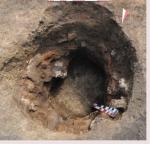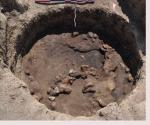Summary (English)
EXPLORATIONS NEAR THE VILLAGE OF SARNEVO (Krum Bacvarov – krum.bacvarov@googlemail.com, Milena Tonkova, Petar Leshtakov, Petar Kalchev, Plamen Karailiev) Stratum 1 with an average thickness of 50 cm was explored at 25 cm in depth. It contained debris from the Late Neolithic period, the Early Iron Age, the Late Iron Age and the Roman period. The lowest intact stratum 2 was 15 – 30 cm in thickness and dated to the Late Neolithic period Karanovo III – IV (second half of the 6th millennium BC). Twenty-seven Late Neolithic ritual dug out structures and pits were explored. The largest structure No. 34 was 11.20 m long, 75 cm deep and had dug outs in its interior. Structure No. 99 was a spherical pit, 1 m in diameter and 95 cm in depth. Its bottom and walls were plastered with clay and its walls were faced with fragments from burned walls of buildings and dolia. The pit was sealed with a layer of burned debris. The structures contained sherds, ceramic vessels, figurines, jewelry (44 beads from shell, Magnetite, Cuprotungstite and Azurite/Malachite, and a pin from Chrysotile), tools from stone, bone and horn, fragmentary querns, horns from ox, deer and goat, and animal bones. A series of 24 radiocarbon dates from eight dug out structures provided 5400 – 5200 cal BC. Remains from a Thracian settlement of the Second Phase of the Early Iron Age (8th – 6th centuries BC) were documented. Twenty-two ritual pits of the 5th – beginning of the 3rd centuries BC were explored. They had peer-like, bell-like, barrel-like and truncated-cone-like shapes and were 0.90 – 3 m in diameter and 0.60 – 1.80 m in depth. The pits contained sherds from Thracian kraters, jugs, cups, a Greek black-gloss lekythos, amphorae and dolia, fragments from eschara with imprinted cord decoration, animal bones, small pieces of charcoal and fragmentary wattle-and-daub. Pit No. 47 contained a skull and part of a backbone of an ox arranged in anatomical order.
- Krum Bacvarov - Archaeological Institute with Museum
- Milena Tonkova - Archaeological Institute with Museum
- Petar Leshtakov - Archaeological Institute with Museum
- Petar Kalchev - Regional Museum of History – Stara Zagora
- Plamen Karailiev - Archaeological Museum ‘Maritsa – East’
Director
Team
Research Body
- Archaeological Institute with Museum
- Archaeological Museum ‘Maritsa – East’
- Regional Museum of History – Stara Zagora






![Download [PDF]](/excavation/skins/fasti/images/results/download_sml.png)



